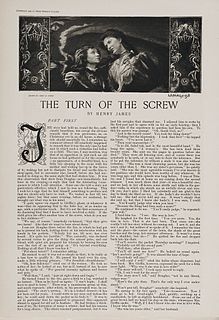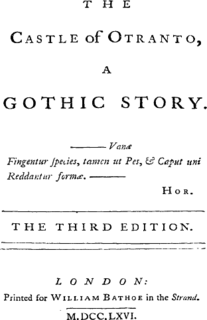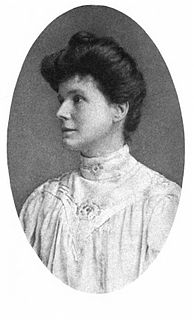
Daniel Defoe was an English writer, trader, journalist, pamphleteer and spy. He is most famous for his novel Robinson Crusoe, published in 1719, which is claimed to be second only to the Bible in its number of translations. He has been seen as one of the earliest proponents of the English novel, and helped to popularise the form in Britain with others such as Aphra Behn and Samuel Richardson. Defoe wrote many political tracts and was often in trouble with the authorities, and spent a period in prison. Intellectuals and political leaders paid attention to his fresh ideas and sometimes consulted him.

Gothic fiction, sometimes called Gothic horror in the 20th century, is a genre of literature and film that covers horror, death and at times romance. It is said to derive from the English author Horace Walpole's 1764 novel The Castle of Otranto, later subtitled "A Gothic Story". Early contributors included Clara Reeve, Ann Radcliffe, William Thomas Beckford and Matthew Lewis. It tends to stress emotion and a pleasurable terror that expands the Romantic literature of the time. The common "pleasures" were the sublime, which indescribably "takes us beyond ourselves." Such extreme Romanticism was popular throughout Europe, especially among English and German-language authors. Its 19th-century success peaked with Mary Shelley's Frankenstein and work by E. T. A. Hoffmann, Edgar Allan Poe and Charles Dickens, and in poetry with Samuel Taylor Coleridge. Also prominent was the later Dracula by Bram Stoker and Strange Case of Dr Jekyll and Mr Hyde by Robert Louis Stevenson. The name Gothic spread from the Goths to mean "German". It also draws in Gothic architecture of the European Middle Ages, where many of the stories occur. Twentieth-century contributors include Daphne du Maurier, Stephen King, Shirley Jackson, Anne Rice and Toni Morrison.

Horror is a genre of speculative fiction which is intended to frighten, scare, or disgust. Literary historian J. A. Cuddon defined the horror story as "a piece of fiction in prose of variable length... which shocks, or even frightens the reader, or perhaps induces a feeling of repulsion or loathing". Horror intends to create an eerie and frightening atmosphere for the reader. Horror is often divided into the psychological horror and supernatural horror sub-genres. Often the central menace of a work of horror fiction can be interpreted as a metaphor for the larger fears of a society. Prevalent elements include ghosts, demons, vampires, werewolves, ghouls, the Devil, witches, monsters, dystopian and apocalyptic worlds, serial killers, cannibalism, psychopaths, cults, dark magic, Satanism, the macabre, gore, and torture.

Joseph Thomas Sheridan Le Fanu was an Irish writer of Gothic tales, mystery novels, and horror fiction. He was a leading ghost story writer of his time, central to the development of the genre in the Victorian era. M. R. James described Le Fanu as "absolutely in the first rank as a writer of ghost stories". Three of his best-known works are the locked-room mystery Uncle Silas, the lesbian vampire novella Carmilla, and the historical novel The House by the Churchyard.

Ann Radcliffe was an English author and a pioneer of Gothic fiction. Her technique of explaining apparently supernatural elements in her novels has been credited with gaining Gothic fiction respectability in the 1790s. Radcliffe was the most popular writer of her day and almost universally admired; contemporary critics called her the mighty enchantress and the Shakespeare of romance-writers, and her popularity continued through the 19th century. Interest has revived in the early 21st century, with the publication of three biographies.

The Turn of the Screw is an 1898 horror novella by Henry James which first appeared in serial format in Collier's Weekly. In October 1898, it was collected in The Two Magics, published by Macmillan in New York City and Heinemann in London. The novella follows a governess who, caring for two children at a remote estate, becomes convinced that the grounds are haunted. The Turn of the Screw is considered a work of both Gothic and horror fiction.

The fantastic is a subgenre of literary works characterized by the ambiguous presentation of seemingly supernatural forces.

The Castle of Otranto is a novel by Horace Walpole. First published in 1764, it is generally regarded as the first gothic novel. In the second edition, Walpole applied the word 'Gothic' to the novel in the subtitle – A Gothic Story. Set in a haunted castle, the novel merged medievalism and terror in a style that has endured ever since. The aesthetic of the book has shaped modern-day gothic books, films, art, music and the goth subculture.

A ghost story may be any piece of fiction, or drama, that includes a ghost, or simply takes as a premise the possibility of ghosts or characters' belief in them. The "ghost" may appear of its own accord or be summoned by magic. Linked to the ghost is the idea of "hauntings", where a supernatural entity is tied to a place, object or person. Ghost stories are commonly examples of ghostlore.

Clara Reeve was an English novelist best known for the Gothic novel The Old English Baron (1777). She also wrote an innovative history of prose fiction, The Progress of Romance (1785). Her first work was a translation from Latin, then an unusual language for a woman to learn.

Ellen Price was an English novelist better known as Mrs. Henry Wood. She is best remembered for her 1861 novel, East Lynne. Many of her books sold well internationally and were widely read in the United States. In her time, she surpassed Charles Dickens in fame in Australia.

Vernon Lee was the pseudonym of the British writer Violet Paget. She is remembered today primarily for her supernatural fiction and her work on aesthetics. An early follower of Walter Pater, she wrote over a dozen volumes of essays on art, music, and travel.

May Sinclair was the pseudonym of Mary Amelia St. Clair, a popular British writer who wrote about two dozen novels, short stories and poetry. She was an active suffragist, and member of the Woman Writers' Suffrage League. She once dressed up as a demure, rebel Jane Austen for a suffrage fundraising event. Sinclair was also a significant critic in the area of modernist poetry and prose, and she is attributed with first using the term 'stream of consciousness' in a literary context, when reviewing the first volumes of Dorothy Richardson's novel sequence Pilgrimage (1915–1967), in The Egoist, April 1918.

Supernatural fiction or supernaturalist fiction is a genre of speculative fiction that exploits or is centered on supernatural themes, often contradicting naturalist assumptions of the real world.

The Haunting of Hill House is a 1959 gothic horror novel by American author Shirley Jackson. A finalist for the National Book Award and considered one of the best literary ghost stories published during the 20th century, it has been made into two feature films and a play, and is the basis of a Netflix series. Jackson's novel relies on terror rather than horror to elicit emotion in the reader, using complex relationships between the mysterious events in the house and the characters’ psyches.
Paranormal television is a genre of reality television. It has changed the program content of some cable networks like the History Channel and the Travel Channel. Its scope comprises purportedly factual investigations of the paranormal, rather than fictional representations found in such shows and films as The Ghosts of Motley Hall, Supernatural, Ghostbusters, Scooby-Doo and Rentaghost. It has spread the popularity of the paranormal by espousing a variety of beliefs on topics ranging from Bigfoot to aliens.

Charles Drelincourt was a French Protestant divine.

The Great God Pan is a horror and fantasy novella by Welsh writer Arthur Machen. Machen was inspired to write The Great God Pan by his experiences at the ruins of a pagan temple in Wales. What would become the first chapter of the novella was published in the magazine The Whirlwind in 1890. Machen later extended The Great God Pan and it was published as a book alongside another story, "The Inmost Light", in 1894. The novella begins with an experiment to allow a woman named Mary to see the supernatural world. This is followed by an account of a series of mysterious happenings and deaths over many years surrounding a woman named Helen Vaughan. At the end, the heroes confront Helen and force her to kill herself. She undergoes a series of unearthly transformations before dying and she is revealed to be a supernatural entity.

Credulity, Superstition and Fanaticism is a satirical print by the English artist William Hogarth. It ridicules secular and religious credulity, and lampoons the exaggerated religious "enthusiasm" of the Methodist movement. The print was originally engraved in 1761, with the title Enthusiasm Delineated, but never published. The original print may have been a response to three essays published by Joshua Reynolds in The Idler in 1759, praising the sublime work of Italian Counter-Reformation artists. Hogarth reworked the engraving before publishing it on 15 March 1762 as Credulity, Superstition and Fanaticism: A Medley. It echoes his earlier print, The Sleeping Congregation of 1736, in which an Anglican clergyman's boring sermon puts his congregation to sleep.
Mrs F. C. Patrick was an 18th-century writer of Gothic fiction with at least three novels to the name. She was one of the earliest female writers of Gothic fiction.



















